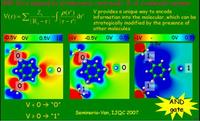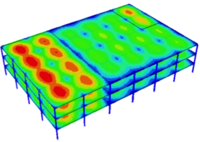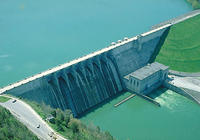-
Making storm warnings more exact, useful
The College of Staten Island (CSI)is the home of one of the most powerful mainframe computer systems in the country, an outgrowth of the City University of New York’s (CUNY) Decade of Science initiative. Following August 2011 Hurricane Irene, CSI scientistsset out to use that computing horsepower to generate scientific data hard enough to make the warnings something more than abstract. They fed millions of data points into the supercomputers, turning an admixture of geology, oceanography, climatology, and land surveys into a set of highly specific projections. Then, on 25 October 2012, Superstorm Sandy hit, and the actual water surges could be measured against the surge projections of the CSI model. On street after street, the computer model predicted flooding to within a foot of the actual surges.
-
-
Testing feasibility of deep geological storage of CO2 emissions
An injection of carbon dioxide, or CO2, has begun at a site in southeastern Washington to test deep geologic storage. Researchers are injecting 1,000 tons of CO2 one-half mile underground to see whether the greenhouse gas can be stored safely and permanently in ancient basalt flows. The United States and portions of Canada have enough potential capacity in geologic formations to store as much as 900 years of CO2 emissions.
-
-
Firefighting robot creates 3D images of burning buildings’ interiors for rescuers
Researchers develop novel robotic scouts that can help firefighters to assist in residential and commercial blazes. The robots will map and photograph the interior of burning buildings by using stereo vision. Working together both collaboratively and autonomously, a number of such vehicles would quickly develop an accurate augmented virtual reality picture of the building interior. They would then provide it in near real time to rescuers, who could better assess the structure and plan their firefighting and rescue activities.
-
-
SkySweeper robot inspects power lines easily, cheaply
Mechanical engineers invented a robot designed to scoot along utility lines, searching for damage and other problems that require repairs. Made of off-the-shelf electronics and plastic parts printed on an inexpensive 3D printer, the SkySweeper prototype could be scaled up for less than $1,000, making it significantly more economical than the two models of robots currently used to inspect power lines.
-
-
Molecule “scanner” uses terahertz radiation to identify single molecules

Molecules could soon be “scanned” in a fashion similar to imaging screenings at airports, thanks to the world’s smallest terahertz detector, developed by University of Pittsburgh physicists. The scanner has the ability chemically to identify single molecules using terahertz radiation — a range of light far below what the eye can detect.
-
-
Eighty-six collegiate teams compete for the best car design and build
Eighty-six teams competed in the Baja Society of Automotive Engineers competition in Bellingham, Washington to determine the Baja car with the best design and build. Every year, collegiate automotive clubs enter to compete in any of the three national competitions that test the design, speed, maneuverability, and endurance of a student-manufactured Baja car — a frame-only vehicle used for off-roading and high adventure activity. Arizona State University’s Sun Devil Motorsports Team improved its ranking from 37th last year to 17th this year.
-
-
Man-induced quakes to help in building safer, sturdier buildings

A team led by Johns Hopkins structural engineers is shaking up a building in the name of science and safety. Using massive moving platforms and an array of sensors and cameras, the researchers are trying to find out how well a two-story building made of cold-formed steel can stand up to a lab-generated Southern California quake.
-
-
Climate change threatens world food security
The last few decades have witnessed a substantial decline in the number of hungry people worldwide. Since 2007, however, progress has slowed and world food supply and demand have been precariously balanced — climate change threatens to tip this balance, most dramatically in the poorer areas of the world.
-
-
U.S. Navy, City of Chicago team up to promote STEM education
The Department of the Navy (DoN) and City of Chicago last month kicked off a unique collaboration to give high school and community college students an intense, hands-on experience in naval-relevant science, technology, engineering and mathematics (STEM) education.
-
-
Locating criminals by tracking their cell phones’ digital fingerprints
To keep from being tracked and getting caught, criminals use evasion tactics such as modifying the built-in ID code in their cell phone or swapping out SIM cards, making it impossible for law enforcement to track the criminals down by relying solely on cell phone signals. German engineers found, however, that the radio hardware in a cellphone — a collection of components like power amplifiers, oscillators, and signal mixers — all introduce radio signal inaccuracies. When these inaccuracies, or errors, are taken together, as seen in the digital signal sent to a cell tower, the result can be read as a unique digital signal –a digital fingerprint. These digital fingerprints do not change even if the built-in ID code has been modified, or the SIM card has been swapped out.
-
-
Water reservoirs for hydroelectric dams are sources of greenhouse gas emissions

The large reservoirs of water behind the world’s 50,000 large dams are a known source of methane. Like carbon dioxide, methane is one of the greenhouse gases which trap heat near Earth’s surface and contribute to global warming. Methane, however, has a warming effect twenty-five times more powerful than carbon dioxide. The methane comes from organic matter in the sediments that accumulate behind dams.
-
-
Dams play an important role in water pollution control

Small dams, reservoirs and ponds trap water pollution, which provides an important benefit to water resources. This is especially relevant in agricultural lands of the Midwest U.S., where there are lots of small, but aging, dams.
-
-
Climate change may fuel extreme wildfires
Climate change may be fueling the larger and more destructive wildfires which are scorching vast areas of the American West, according to new research. August 2012 saw 3.6 million acres burn in the region, the most of any August since 2000. There were, however, only 6,948 fires in August 2012 — the second fewest in that 12-year timeframe — meaning the fires were much larger.
-
-
Bacteria to clean contaminated leftover water used in fracking

Fracking is a drilling technique which uses lots of water — up to 5-7 million gallons per frack. One well may be fracked several times. The water goes in clean and comes out contaminated with organic substances that render it unfit for reuse. Purifying that water would reduce the pressure on waste disposal sites called injection wells, as well as on sites of wastewater spills. Researchers say that bacteria may someday clean leftover frack water.
-
-
Quake Summit 2013: showcasing research on earthquakes, tsunamis
Members of a national earthquake simulation research network next week will gather at the University of Nevada, Reno (UNR), for Quake Summit 2013, a scientific meeting highlighting research on mitigating the impact of devastating earthquakes and tsunamis. Titled “Earthquake & Multi-Hazards Resilience: Progress and Challenges,” the annual summit of the 14-site George E. Brown Network for Earthquake Engineering Simulation (NEES), will run from 6 August through 8 August at UNR’s Joseph Crowley Student Center.
-
More headlines
The long view
A Shining Star in a Contentious Legacy: Could Marty Makary Be the Saving Grace of a Divisive Presidency?
While much of the Trump administration has sparked controversy, the FDA’s consumer-first reforms may be remembered as its brightest legacy. From AI-driven drug reviews to bans on artificial dyes, the FDA’s agenda resonates with the public in ways few Trump-era policies have.
Risk Assessment with Machine Learning
Researchers utilize geological survey data and machine learning algorithms for accurately predicting liquefaction risk in earthquake-prone areas.
Foundation for U.S. Breakthroughs Feels Shakier to Researchers
With each dollar of its grants, the National Institutes of Health —the world’s largest funder of biomedical research —generates, on average, $2.56 worth of economic activity across all 50 states. NIH grants also support more than 400,000 U.S. jobs, and have been a central force in establishing the country’s dominance in medical research. Waves of funding cuts and grant terminations under the second Trump administration are a threat to the U.S. status as driver of scientific progress, and to the nation’s economy.
The True Cost of Abandoning Science
“We now face a choice: to remain at the vanguard of scientific inquiry through sound investment, or to cede our leadership and watch others answer the big questions that have confounded humanity for millennia —and reap the rewards.”
Bookshelf: Smartphones Shape War in Hyperconnected World
The smartphone is helping to shape the conduct and representation of contemporary war. A new book argues that as an operative device, the smartphone is now “being used as a central weapon of war.”
New Approach Detects Adversarial Attacks in Multimodal AI Systems
New vulnerabilities have emerged with the rapid advancement and adoption of multimodal foundational AI models, significantly expanding the potential for cybersecurity attacks. Topological signatures key to revealing attacks, identifying origins of threats.
